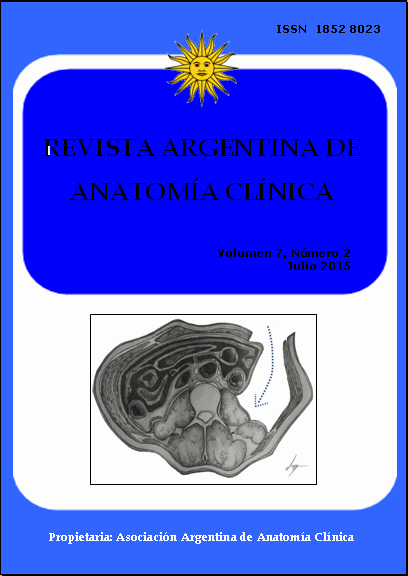GASTROCNEMIUS TUBERCLE IN INDIAN POPULATION: A NEW ANATOMICAL ENTITY?. Tubérculo gastrocnemio en la población india: Una nueva entidad anatómica?
DOI:
https://doi.org/10.31051/1852.8023.v7.n2.14175Palabras clave:
Gastrocnemius tubercle, femur, medial condyle, tubérculo gastrocnemio, fémur, cóndilo medialResumen
Los libros de texto comunes de anatomía describen dos protuberancias óseas presentes en el cóndilo medial del fémur. A parte del tubérculo aductor (TA) y del epicóndilo medial (EPM) del fémur también se ha observado una tercera protuberancia ósea en muchos huesos. En la literatura publicada previamente se lo denomina tubérculo gastrocnemio. La cabeza medial del músculo gastrocnemio y el ligamento oblicuo posterior están adheridos al mismo. Hemos observado 396 (derecha-204 e izquierda-192) fémures secos de pacientes indios. Se observó la presencia en el cóndilo medial de la tercera protuberancia ósea, es decir, el tubérculo gastrocnemio (TGC) junto con el tubérculo aductor y el epicóndilo medial. Se advirtió la presencia o ausencia de TGC. Se comparó el tamaño del TGC y del TA. Se midió la distancia entre TA y TGC y se midió asimismo la distancia entre TGC y EPM utilizando un calibre vernier digital con un grado de precisión de hasta 0,01 mm. Para la elaboración de datos se calculó el porcentaje, la distancia media, el rango y la desviación estándar. Se comprobó la presencia de TGC en 207 huesos, es decir 52,27% (derecha-109 e izquierda-98). En la mayoría de los fémures (80,7%) el TA es de tamaño mayor que el TGC. La distancia media entre TGC y TA en el lado derecho es 10,8 ± 2,4 mm y en el lado izquierdo es 10,9 ± 2,3. Se observó una distancia entre TGC y EPM de 14,8 ± 0,5 mm en el lado derecho y de 14,9 ± 2.9 mm en el lado izquierdo. Las diferencias bilaterales no son significativas en términos estadísticos. Es importante para los clínicos identificar el TGC para evitar la reparación no anatómica de lesiones del ligamento medial de la rodilla.
The standard textbooks of anatomy describe two bony prominences on the medial condyle of femur. In addition to adductor tubercle (AT) and medial epicondyle (MEP) of femur a third bony prominence was also observed in many bones. In previously published literature it was named as gastrocnemius tubercle. The medial head of gastrocnemius muscle and posterior oblique ligament were attached close to it. We observed three hundred and ninety six (right-204 and left-192) dry femora belonging to Indian population. The medial condyle was observed for the presence of third bony prominence - gastrocnemius tubercle (GCT) along with adductor tubercle and medial epicondyle. The presence or absence of GCT was noted. The size of GCT and AT was compared. The distance between the most prominent point on AT and GCT and between GCT and MEP was measured using digital Vernier caliper accurate up to 0.01 mm. The percentage, mean, range and standard deviation was calculated for the data. Presence of GCT was noted in 207 bones (52.27%) (right-109 and left-98). In majority (80.7%) of the femora AT was larger than GCT. Mean distance between GCT and AT on right side was 10.8 ± 2.4 mm and on left side it was 10.9 ± 2.3. Distance between GCT and MEP on right side was observed as 14.8 ± 0.5 mm and on left side 14.9 ± 2.9. The bilateral differences were not significant statistically. It is important for clinicians to identify GCT to avoid non-anatomical repair of medial knee injuries.
Referencias
Basmajian J, Slonecker CE. 1989. Femur and Front of thigh. Grant’s method of Anatomy. 11th Ed. New Delhi: Waverly international. 261 p.
Campbell JG. 1966. A dinosaur bone lesion resembling avian osteopetrosis and some remarks on the mode of development of the lesion. J of Royal microscopic soc 85: 163-74.
Fang L, Yue B, Gadikota HR, Kozanek M, Liu W, Gill TJ, Rubash HE, Li G. 2010. Morphology of the medial collateral ligaments of the knee. J of Orthopedic surgery and research 5: 69.
Jones FW. 1953. The bones of the lower limb. Buchanan’s manual of Anatomy.8th Ed. London, UK: Bailliere, Tindall and Cox. 334-35.
LaPrade RF, Engebretsen AH, Thuan VL, Johansen S, Wentorf FA, Engebretsen L. 2007. The anatomy of the medial part of the knee. J of Bone Joint surg Am 89: 2000-10.
Liberman P. 1984 The Evolution of human speech: comparative studies. Biology of Evolution of Language. USA: Harvard Univ. press. 260 p.
McMinn RMH. 1990. Lower limb. Last’s Anatomy Regional & Applied. 8th Ed. London: Churchill Livingstone. 223 p.
Moore KL, Dalley AF, Agur AMR. 2010. Lower limb. Clinically oriented Anatomy. 6th Ed. Baltimore: Lippincott Williams & Wilkins. 565 p.
Romanes GJ. 1887. Bones. Cunnigham’s textbook of Anatomy. 12th Ed. New York: Oxford Medical Publications. 188 p.
Snell RS. 2008. The lower limb. Clinical Anatomy by regions. 8th Ed. Meryland, USA: Lippincott Williams & Wilkins. 561 p.
Standring S. 2008. Pelvic girdle, gluteal region and thigh, Gray’s Anatomy: the Anatomical basis of clinical practice. 40th Ed. London, UK: Elsvier Ltd. 1363 p.
Wijdicks CA, Griffith CJ, LaPrade RF, Johansen S, Sunderland A, Arendt EA, Engebretsen L.2009. Radiographic identification of the primary medial knee structures. J of Bone Joint Surg Am 91: 521-29.
Descargas
Publicado
Número
Sección
Licencia
Los autores/as conservarán sus derechos de autor y garantizarán a la revista el derecho de primera publicación de su obra, el cuál estará simultáneamente sujeto a la Licencia de reconocimiento de Creative Commons que permite a terceros compartir la obra siempre que se indique su autor y su primera publicación en esta revista. Su utilización estará restringida a fines no comerciales.
Una vez aceptado el manuscrito para publicación, los autores deberán firmar la cesión de los derechos de impresión a la Asociación Argentina de Anatomía Clínica, a fin de poder editar, publicar y dar la mayor difusión al texto de la contribución.



